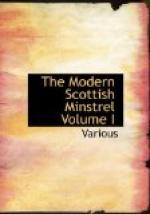From the rural retirement of Gartur, she soon removed to the town of Stirling; but in 1810, as her circumstances became more prosperous, she took up her permanent abode in Edinburgh. Some distinguished literary characters of the Scottish capital now resorted to her society. She was visited by Sir Walter Scott, Francis Jeffrey, James Hogg, and others, attracted by the vivacity of her conversation. The “Essays on the Superstitions of the Highlanders of Scotland” appeared in 1811, in two volumes; in 1814, she published a metrical work, in two parts, entitled “Eighteen Hundred and Thirteen;” and, in the year following, she produced her “Popular Models and Impressive Warnings for the Sons and Daughters of Industry.”
In 1825, Mrs Grant received a civil-list pension of L50 a-year, in consideration of her literary talents, which, with the profits of her works and the legacies of several deceased friends, rendered the latter period of her life sufficiently comfortable in respect of pecuniary means. She died on the 7th of November 1838, in the eighty-fourth year of her age, and retaining her faculties to the last. A collection of her correspondence was published in 1844, in three volumes octavo, edited by her only surviving son, John P. Grant, Esq.
As a writer, Mrs Grant occupies a respectable place. She had the happy art of turning her every-day observation, as well as the fruits of her research, to the best account. Her letters, which she published at the commencement of her literary career, as well as those which appeared posthumously, are favourable specimens of that species of composition. As a poet, she attained to no eminence. “The Highlanders,” her longest and most ambitious poetical effort, exhibits some glowing descriptions of mountain scenery, and the stern though simple manners of the Gael. Of a few songs which proceed from her pen, that commencing, “Oh, where, tell me where?” written on the occasion of the Marquis of Huntly’s departure for Holland with his regiment, in 1799, has only become generally known. It has been parodied in a song, by an unknown author, entitled “The Blue Bells of Scotland,” which has obtained a wider range of popularity.




